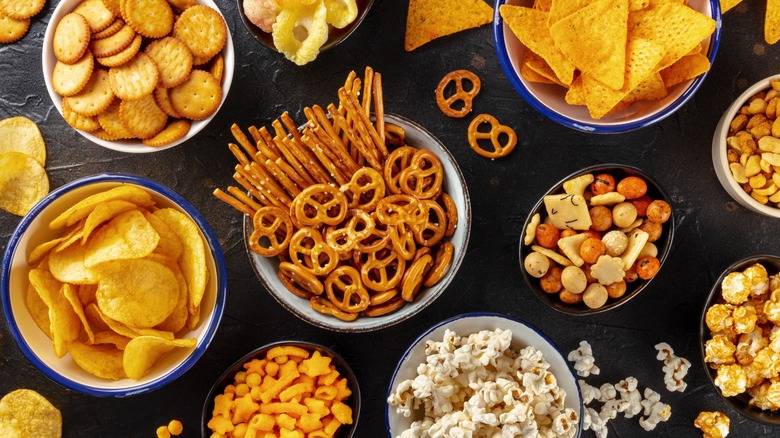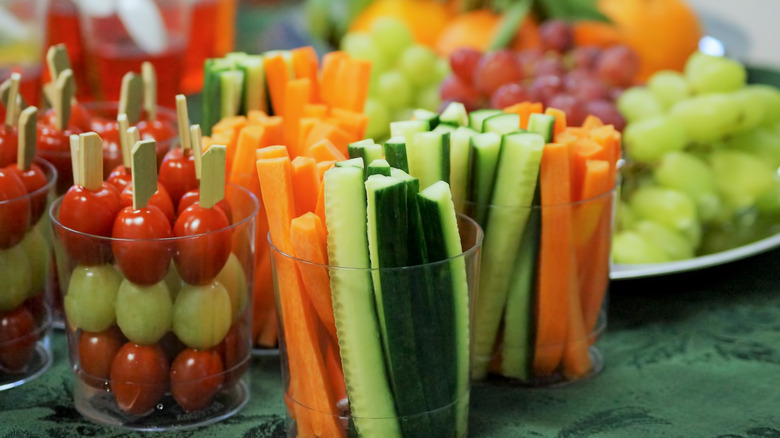The Difference Between Crispy And Crunchy Textures
We spend a lot of time talking about the flavor of our food, but texture can be an equally important part of our eating experience. It's fundamental to the satisfaction we experience when biting into a perfectly crisp apple and the unrelenting allure we feel in the presence of a bag of crunchy potato chips, and it subconsciously impacts our perception of a particular food's freshness, whether raw or processed. Or is it a crunchy apple and crispy chips?
While crispy and crunchy are often used in conjunction or interchangeably, they describe different kinds of foods that produce different sounds, require different amounts of force to bite into, and are generally navigated differently in the mouth. It may seem pedantic, but just as their firm texture is crucial, so too is understanding what distinguishes them. Thankfully, scientists have worked hard to illuminate the finer points of each texture and have learned how to produce and maintain them in manufactured products — clearly, this is a topic worth sinking your teeth into.
What differentiates these textures?
When you stop to consider these two words, you may find that you have an intuitive sense of which ingredients fall into each category. While there are exceptions and disagreements about how foods are classified, having general guidelines helps us clearly and accurately communicate the texture we desire.
The most common classification principle is the amount of force needed to eat something, per a 2013 study published by the International Journal of Food Properties. Crispy foods are generally thin and require very little pressure to bite through. Many are so brittle they shatter upon impact — think potato chips, sheets of nori, the fried exterior of a spring roll, or the caramelized sugar on top of creme brulee. But others in the category take a bit more effort to bite into — like the browned cheese on a corner piece of lasagna, the cracker thin crust of Chicago's tavern-style pizza, or a grilled cheese cooked in mayo (not butter). Since they're softer, you typically eat these foods with your front teeth and they produce higher-pitch sounds.
Crunchy foods are generally dense, require more force to bite into, and produce bigger, lower-pitch sounds when eaten. A raw carrot, nuts, croutons, and thick-cut or kettle-cooked potato chips are all in this category. You may first bite them with your front teeth, but your molars are needed to break it down into something you can swallow. Celery transcends these categories and is considered both crispy and crunchy.
How these words impact our perception of food
It may be because firm textures have been associated with freshness for millions of years, or because the sounds firm foods produce when we eat them keep us engaged and allow us to experience more enjoyment, or something else altogether. What we do know is that, around the world, crispy and crunchy foods are incredibly popular. As a result, more and more are manufactured to entice us at the supermarket.
Though individuals don't always assign the same adjective to the same foods, perceptions of the words "crispy" and "crunchy" are consistent across the board. In a 2013 study published by the International Journal of Food Properties, researchers reported crunchiness was "regarded with warmth and described as active, energetic, and appealing," while crispiness was seen as a sign of great culinary skill.
With so many fond associations, it makes sense that we are always looking to uncover the secret to extra crispy air fryer chicken wings, looking for tips for making your roasted potatoes even crispier, and trying to keep produce crunchy for as long as possible. Whether trying to maintain freshness or elevate our cooking to the level of culinary masters, many of our favorite foods are just better at their crispiest and crunchiest.



